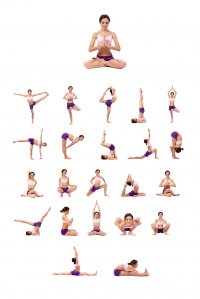Yoga Poses
Many statues have been found depicting deities resembling Lord Shiva and Parvati performing various asanas and practicing meditation, in the archaeological excavations at Harappa and Mohenjodaro, now in modern Pakistan. According to tradition, Shiva is said to have been the founder of Yoga; and Goddess Parvati, His first disciple.
In the yogic scriptures it is said that there were originally 8,400,000 yoga poses, knowns as asanas. And it is believed that only Lord Shiva, the originator of Yoga, is conversant with all the asanas. As per ancient Indian tradition, these poses represent the 8,400,000 incarnations every individual must pass through before attaining liberation (moksa) from the cycle of birth and death.

These are considered to represent a progressive evolution from the simplest form of life to the most complex – that of a fully realized human being. Through their regular practice, it is possible to mitigate the effects of and side step the karmic process and bypass many evolutionary stages in one lifetime.
While there are 84,000 principal asanas; 8,400 among them have been predominantly practised through the ages. Out of these, 84 are considered important and 32 as very important. Eight have been ranked as the most important. Even among these, four are singled out for special mention; two of which are classified as outstanding and finally, one is rated is rated as superior to all others.
Interestingly, man’s connection with nature is emphasized in the naming of the asanas. They have mostly been named after animals, insects, birds; as well as trees and flowers. After keen observation, the sages realised that there are certain qualities and shapes unique to each species, beyond human beings. Each of them adopts a certain pose when it is ready to attack/defend/flee, as well as when it is relaxing. Yoga is primarily concerned with relaxation postures. Some asanas have been named after the body parts associated with them; while a few are named after the sages who created and popularised them.